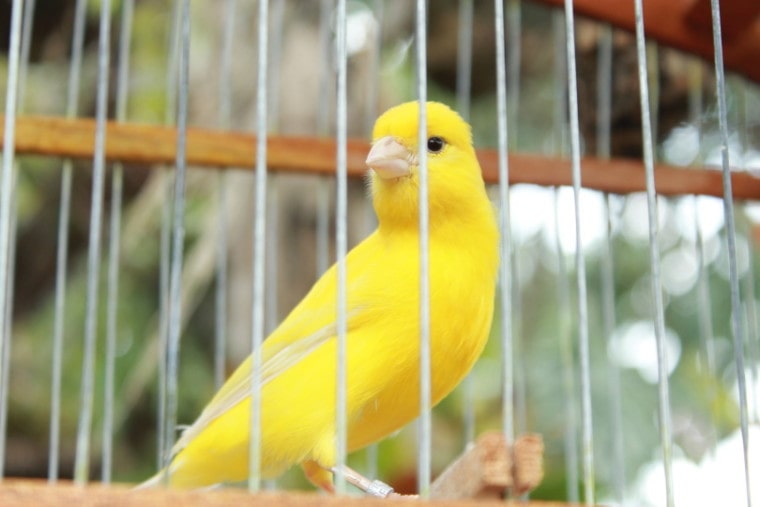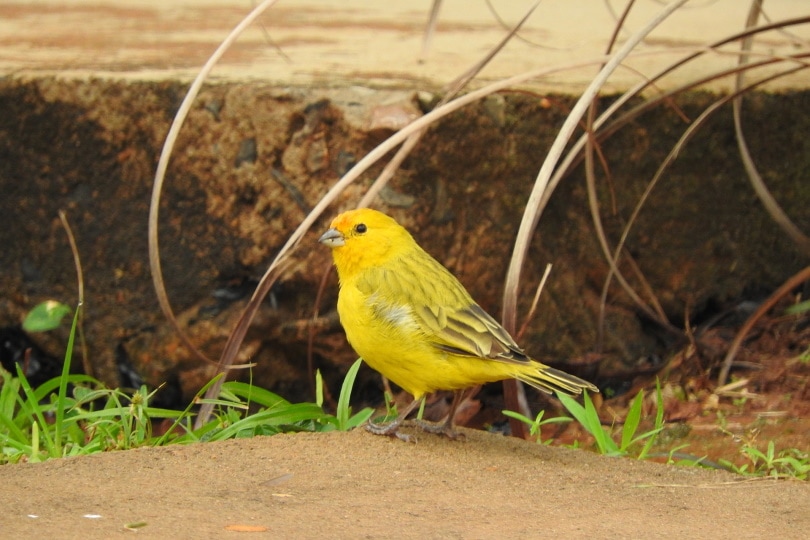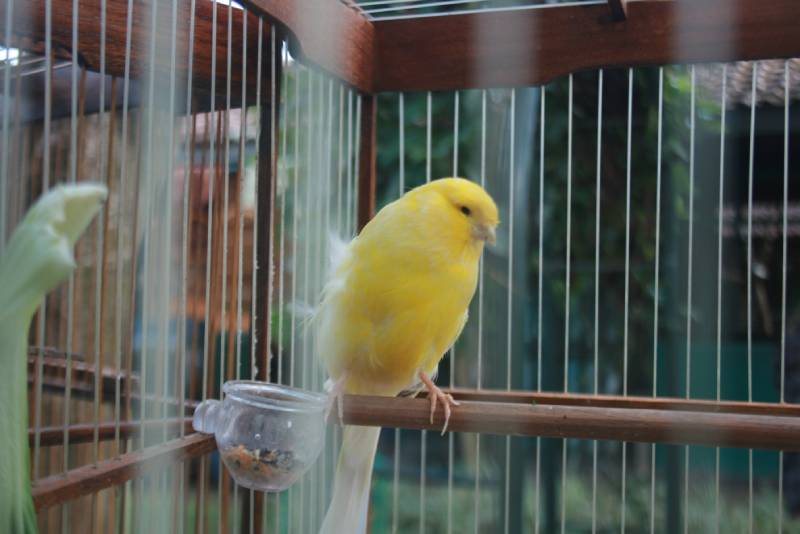
The yellow canary is a type of finch with a cheerful temperament and beautiful songs that make it a popular pet. With a reputation as a beginner bird, many people acquire canaries and become lifelong fans of the species. Find out everything you need to know about keeping yellow canaries and decide if it’s the right pet for your needs.

Species Overview
| Common Names: | Canary, yellow canary, domestic canary |
| Scientific Name: | S. canaria domestica |
| Adult Size: | 4.5 to 8 inches |
| Life Expectancy: | 5 to 15 years |

Origin and History
Native to the Macaronesian Islands of the Canary Islands, Madeira, and the Azores, the yellow canary has been a popular pet species since the 17th century. When the Spanish conquered the Macaronesian Islands in the 15th century, sailors brought the birds back to Europe, leading to breeding for the pet trade.
Despite their early history, modern canaries are genetically different from their wild canary counterparts after years of breeding. Canaries can be bred with finches successfully, leading to hybrid species with unique personalities and coloration. Regardless of the type or hybrid, most pet canaries have gentle and friendly demeanors.
Temperament
One of the best aspects of canaries as pets is that they enjoy relationships with their human companions. Unlike other pet birds, such as parrots, canaries enjoy accompanying their owners, but they don’t like to be handled often. They prefer a more passive relationship with their owners and enjoy hanging out nearby or flying around the house.
Highly intelligent, canaries can be trained to move from perch to perch, fly from one spot to another, and sit on their owner’s hand. Canaries are solitary birds and are comfortable being alone, though they have an excellent temperament for an aviary with other small birds. That said, two males in one enclosure may fight over dominance or territory, especially during the breeding season, so it’s best to keep males alone or house a male with females. If housed alone, your yellow canary should have plenty of toys to play with and get exercise.

Speech & Vocalizations
One of the perks of owning a yellow canary is its song. Several varieties are known for singing, including the Harz Roller, the Waterslager, and the American Singer. Males are the primary songbirds and can come up with beautiful, elaborate songs and vocalizations. Females typically chirp and whistle. Beyond singing, canaries are usually quieter birds and good choices for apartments or households with family members that are sensitive to sound. Neither male nor female canaries will sing during the molting period when they shed old feathers and replace them with new ones. Canaries molt during the summer months and the process takes between 6 and 12 weeks.
Yellow Canary Colors and Markings
As the name suggests, wild canaries are yellow or greenish-yellow on the main part of their bodies. The underside is bright yellow. In the pet trade, canaries come in a variety of colors, including white, orange, full yellow, and red. Hybrid breeding with finches yields even more vibrant and diverse coloration.

Caring for the Yellow Canary
One of the most important aspects of keeping canaries, especially alone, is getting a large enough cage. A sole yellow canary should have a cage that’s at least 20 inches wide and 24 inches long to have space to fly. The ideal orientation is a long cage with a narrow width, which maximizes flying space. Cages should have closely spaced bars or wire mesh to prevent this small bird from escaping.
Another essential element of your cage are various wood perches of different girths and lengths. Your canary can get exercise by flying from perch to perch and resting as needed. Be sure to get perches that have irregular surfaces for gripping, but avoid sandpaper covers that may damage your canary’s feet.
Like other birds, canaries enjoy bathing. Your cage will need at least one water dish and one bathing dish. If possible, include an additional water dish to give your canary options.
Canaries are suitable for beginners because they’re a hardy species. They don’t require any additional heating or special lighting, but you should avoid keeping your cage near air conditioners and windows with direct sunlight. Your cage should be covered with a blanket to simulate a light/dark cycle for your canary to rest.
Common Health Problems
Diet and Nutrition
Wild canaries eat a diet of seeds and insects. Your pet canary will do well on a high-quality seed mix with added vitamins. Many commercial feed options are available with the proper nutritional profile for canaries and finches. Pellets are available as well, but they’re not as enjoyable for your bird.
You can boost your canary’s nutrition with fruits and vegetables like apples, grapes, celery, spinach, melons, and dandelion greens. Small pieces of a hard-boiled egg add protein.
In addition to feeding proper food, you need to keep your canary’s food dish clean. As birds eat seeds, they leave the hulls behind. If you don’t remove the hulls, your canary won’t be able to access its fresh food easily. Each day, clear out the top layer of seed hulls and mix some new food with the old food. This way, you ensure your canary always has access to fresh food and the existing food won’t spoil.

Exercise
Yellow canaries are very active birds. Your cage should have plenty of perches for flying and exercise, but not so many to be cluttered. Just a few toys, a mirror, and some perches are all your canary needs to have fun and get exercise.
After adjusting to its new home, you can let your canary out to fly around the house. Ideally, your canary should have an hour or two of free flight in your home. Before letting your bird out, close the windows and doors, turn off fans and air conditioners, and take other pets out of the room. Be sure to supervise your canary during free flight to keep it safe.

Where to Adopt or Buy a Yellow Canary

Canaries are available in many pet stores and cost between $25 and $150. If you want a special variety or color, the best option is a canary breeder. Before you buy a canary, check into the breeder or pet store to see how their animals are sourced, and if possible, ask to see the facility and the other birds in their care.
Because canaries are often easier to care for than other birds, they’re not as abundant in adoption programs. If you prefer to adopt, you can contact your local rescue organizations and bird-specific rescues to see if any canaries need a good home.

Conclusion
If you want a low-maintenance and friendly bird for your household, the yellow canary is a great choice. Canaries are easy to care for, enjoy human companionship, and have low requirements for caging, diet, and bird companions. Best of all, canaries come in a variety of unique colors and patterns, so you can get the beauty of an exotic bird in an easygoing, low-fuss package.
Next on your reading list:
Featured Image Credit: rafarabassa92. Pixabay








